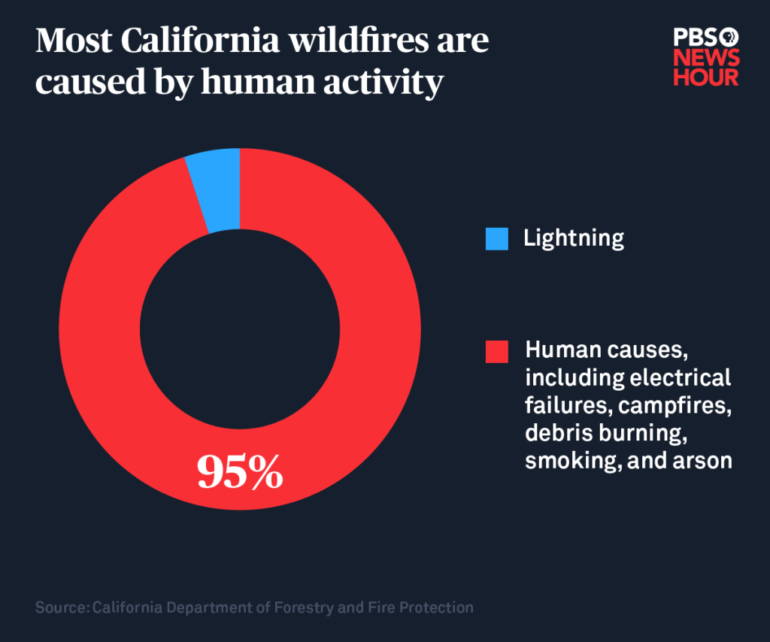Human-caused wildfires in California are more ferocious than blazes sparked by lightning, a team led by scientists from the University of California, Irvine reported recently in the journal Nature Communications. The research could help scientists better understand fire severity and how likely a blaze is to kill trees and inflict long-term damage on an ecosystem in its path.
California is no stranger to wildfires; in 2020 alone, over 4 million acres burned across the state, including the million-acre August Complex Fire. But what’s been unclear until now was whether there was any difference in severity between wildfires that start naturally, from lightning strikes, versus those touched off by humans.
“Human-ignited fires grow more rapidly and release more energy as they’re growing because they’re often sparked under conditions that are hotter and drier,” said James Randerson, Ralph J. and Carol M. Cicerone Professor of Earth system science at UCI and co-author of the study. “They’re more ferocious.”
In contrast, lightning-strike blazes typically occur in weather with somewhat higher humidity, which can limit flame intensity.
The work was made possible by UCI advances in fire modeling that enable scientists to better understand the forces that govern how fast blazes move. Those advances were detailed in a separate new study published in Scientific Data.
“We created a fire tracking algorithm and applied it to the past nine fire seasons in California, which helped analyze the location, energy and spread of different types of fires,” said Yang Chen, an assistant researcher in the Department of Earth System Science.
To build their algorithm, Chen and colleagues looked at thermal hotspots from fire activity with an imaging device on the National Oceanic and Atmospheric Administration’s Suomi satellite. This allows for near-real-time tracking and modeling of wildfires.
“These types of data have been available in the past for individual fires,” said Randerson. “But it hasn’t been organized systematically, and it hasn’t been available across all the fires in a region. That’s where this new product helps. It allows us to identify where in California the fires burn fastest and how that relates to the weather and vegetation at a particular spot.”
This two-study effort was also one of the first times scientists have been able to link a fire’s speed and energy release to its long-term effects on ecosystems—which can last for decades or even centuries. “The importance of this algorithm is that it could allow us to build better fire models in California and better track wildfires in parts of the world where we don’t have aircraft and multiple satellite sensors measuring fires around the clock,” Randerson added. “So this may be valuable for understanding fire behavior in remote boreal forests and in the understory of tropical forests.”
Both new studies have special relevance for California, where increasing fire severity is leading to more and more property damage, civilian and fire firefighter fatalities, ecosystem degradation and poor air quality. Co-author Douglas Morton and visualization engineer Cynthia Starr from NASA’s Goddard Space Flight Center created animations of these new data for the Caldor fire and the Dixie fire. These two fires had devastating impacts on several California communities in the Sierra Nevada mountains during the 2021 wildfire season. The data visualizations for these fires illustrate how quickly fire behavior can change from day-to-day variations in weather and the fires burning into new areas with different levels of fuel accumulation.
The two studies included contributions from researchers at NASA’s Goddard Space Flight Center, Universidad del Rosario in Bogotá, Colombia, and Cardiff University in the United Kingdom.
More information:
Stijn Hantson et al, Human-ignited fires result in more extreme fire behavior and ecosystem impacts, Nature Communications (2022). DOI: 10.1038/s41467-022-30030-2
Yang Chen et al, California wildfire spread derived using VIIRS satellite observations and an object-based tracking system, Scientific Data (2022). DOI: 10.1038/s41597-022-01343-0
Provided by
University of California, Irvine
Citation:
Human-triggered California wildfires are more severe than natural blazes (2022, June 6)



